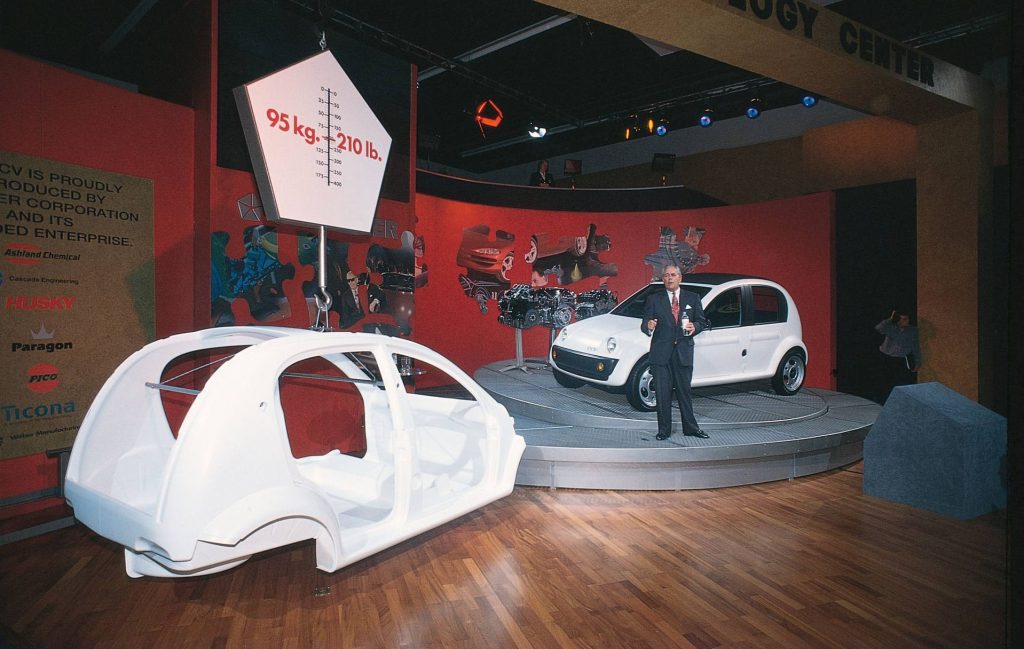Make cars safer, cleaner and greener, and you make them more expensive. And at some point this butts heads with the necessary evil of profit margins: The difference between designing, engineering, developing and producing an Up and a Golf is minimal on VW’s bottom line, but it has to sell one at half the price of the other.
Today, the formula is making Volkswagen Ups, Peugeot 108s and Smart Fortwos a dying breed. But 25 years ago, Chrysler was one of several manufacturers attempting to make small cars cheaper by building them smarter. And inadvertently or otherwise, it created a modern-day Citroën 2CV.

Called the Chrysler CCV, the name originally stood for China Concept Vehicle, a nod to its intended audience (in 1997, China’s automotive market was somewhat different from today’s technology-focused behemoth).


It was later re-dubbed Composite Concept Vehicle, but read that slowly: CCV. Two C… V. Even if you ignored its friendly face, arched and roll-back fabric roof and large wheelarches, it’s a cultural reference as subtle as dressing up in a striped sweater and a string of onions.
Under the CCV’s front-hinged bonnet sat an 800cc Briggs & Stratton V-twin (two cylinders being another 2CV cue), sending 25bhp to the front wheels via a four speed gearbox – controlled by a lever poking its way straight through the dashboard. Truly, an uncanny coincidence.
The 2CV wasn’t just a funny shape though: almost everything on Citroën’s 1948 masterpiece was designed in the pursuit of simplicity. And so it was with the 1997 CCV, where the “Composite” portion of its name held a clue to the clever method of its construction. The car’s entire body was formed from recycled plastic – the equivalent of 2132 old two-litre drinks bottles.

Chrysler partnered with Cascade Engineering in Michigan on the project. You probably haven’t heard of them, but if you’ve ever been to North America you’ll have seen its wares: they’re big, green, and hang out in dark alleys.
Injection-moulded plastic dumpsters are everywhere in the US, and the CCV’s body was made using the same process, squeezing the equivalent of 2132 two-litre plastic bottles under 9000 tonnes of pressure to form four large body parts. These parts were then bonded together – a pair of outer panels, and a pair of inner panels that attach to them – and the finished structure (weighing just 95kg) would then be bolted and glued onto a 2CV-style flat floorpan to receive its plastic doors, bumpers and bonnet.
End to end, Chrysler reckoned it’d take six or seven hours to build a CCV, against the 19 hours of the contemporary Neon. Some of that saving came from not requiring any paint – the injection-moulded plastics were pre-coloured, which not only saved time but eliminated the environmentally dubious, energy-intensive and space-consuming paint shop process.

True to its inspiration, the CCV was economical in every sense; to produce, to repair (the body was springy and dent-resistant, but repair patches could essentially be melted into place and the damaged pieces recycled once more) and to run. Chrysler claimed 50mpg (pretty decent in the 1990s), while a 545kg kerbweight pretty much guaranteed low brake and tyre wear.
Economical to buy, too. Chrysler suggested a production model might come in at around £4000, a third that of a Neon, two grand less than a Kia Pride in 1997, and £995 cheaper even than the how-was-that-still-on-sale Lada Samara. Inflation-adjusted, that’s about £7750.
Whether customers would have accepted something 2CV-basic in the late ‘90s is unclear, though the idea of a car with no airbags, no air conditioning, large slide-down windows and a 70mph top speed was probably more palatable in a new car a quarter-century ago than it sounds today.
Ultimately Chrysler’s answer to the tin snail reached a line of salt, despite its cost advantages. It’s likely, given the construction, that crash testing proved a somewhat literal barrier, while cheap cars in emerging markets were already more sophisticated in many ways. As automotive giant Tata found out to its cost with the absurdly cheap Nano, even buyers trading up from a moped don’t want to be seen in something overtly austere.
There’s depressing irony in the way regulations designed to make cars safer and more environmentally friendly are killing off those that have the least holistic impact: the cars that are most affordable, cause the least damage when they hit something, are lightest on resources, and take up the least space on the roads.
The world wouldn’t necessarily be a better place if it was full of cars like the Chrysler CCV – though it might be a jollier one – but it showed that smaller, more affordable cars were still possible if you just took inspiration from the right places.
Read more
The Chrysler Neon was a gutsy slice of American pie
Cars That Time Forgot: 1963 Chrysler Turbine
French revolution: 5 game-changing Citroëns








